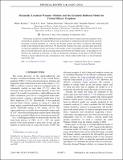| dc.contributor.author | Koshino, Mikito | |
| dc.contributor.author | Yuan, Noah F. Q. | |
| dc.contributor.author | Koretsune, Takashi | |
| dc.contributor.author | Ochi, Masayuki | |
| dc.contributor.author | Kuroki, Kazuhiko | |
| dc.contributor.author | Fu, Liang | |
| dc.date.accessioned | 2018-10-18T18:33:09Z | |
| dc.date.available | 2018-10-18T18:33:09Z | |
| dc.date.issued | 2018-09 | |
| dc.date.submitted | 2018-05 | |
| dc.identifier.issn | 2160-3308 | |
| dc.identifier.uri | http://hdl.handle.net/1721.1/118612 | |
| dc.description.abstract | We develop an effective extended Hubbard model to describe the low-energy electronic properties of the twisted bilayer graphene. By using the Bloch states in the effective continuum model and with the aid of the maximally localized algorithm, we construct the Wannier orbitals and obtain an effective tight-binding model on the emergent honeycomb lattice. We find that the Wannier state takes a peculiar three-peak form in which the amplitude maxima are located at the triangle corners surrounding the center. We estimate the direct Coulomb interaction and the exchange interaction between the Wannier states. At the filling of two electrons per supercell, in particular, we find an unexpected coincidence in the direct Coulomb energy between a charge-ordered state and a homogeneous state, which could possibly lead to an unconventional many-body state. | en_US |
| dc.description.sponsorship | United States. Department of Energy. Division of Materials Sciences and Engineering (Award DE-SC0010526) | en_US |
| dc.description.sponsorship | David & Lucile Packard Foundation | en_US |
| dc.publisher | American Physical Society | en_US |
| dc.relation.isversionof | http://dx.doi.org/10.1103/PhysRevX.8.031087 | en_US |
| dc.rights | Creative Commons Attribution | en_US |
| dc.rights.uri | http://creativecommons.org/licenses/by/3.0 | en_US |
| dc.source | American Physical Society | en_US |
| dc.title | Maximally Localized Wannier Orbitals and the Extended Hubbard Model for Twisted Bilayer Graphene | en_US |
| dc.type | Article | en_US |
| dc.identifier.citation | Koshino, Mikito, et al. “Maximally Localized Wannier Orbitals and the Extended Hubbard Model for Twisted Bilayer Graphene.” Physical Review X, vol. 8, no. 3, Sept. 2018. © 2018 American Physical Society | en_US |
| dc.contributor.department | Massachusetts Institute of Technology. Department of Physics | |
| dc.contributor.mitauthor | Fu, Liang | |
| dc.contributor.mitauthor | Yuan, Noah F. Q. | |
| dc.relation.journal | Physical Review X | en_US |
| dc.eprint.version | Final published version | en_US |
| dc.type.uri | http://purl.org/eprint/type/JournalArticle | en_US |
| eprint.status | http://purl.org/eprint/status/PeerReviewed | en_US |
| dc.date.updated | 2018-09-28T18:00:24Z | |
| dc.language.rfc3066 | en | |
| dspace.orderedauthors | Koshino, Mikito; Yuan, Noah F. Q.; Koretsune, Takashi; Ochi, Masayuki; Kuroki, Kazuhiko; Fu, Liang | en_US |
| dspace.embargo.terms | N | en_US |
| dc.identifier.orcid | https://orcid.org/0000-0002-8803-1017 | |
| mit.license | PUBLISHER_CC | en_US |
